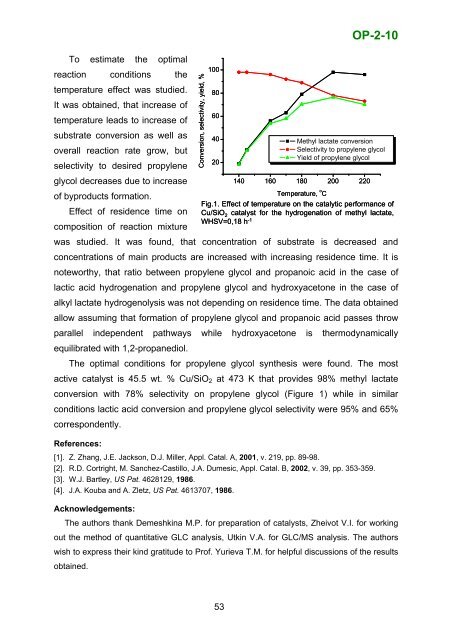Boreskov Institute of Catalysis SB RAS, Novosibirsk, Russia
Boreskov Institute of Catalysis SB RAS, Novosibirsk, Russia
Boreskov Institute of Catalysis SB RAS, Novosibirsk, Russia
- No tags were found...
Create successful ePaper yourself
Turn your PDF publications into a flip-book with our unique Google optimized e-Paper software.
To estimate the optimal100OP-2-10reaction conditions thetemperature effect was studied.80It was obtained, that increase <strong>of</strong>temperature leads to increase <strong>of</strong>substrate conversion as well asoverall reaction rate grow, butselectivity to desired propylene604020Methyl lactate conversionSelectivity to propylene glycolYield <strong>of</strong> propylene glycolglycol decreases due to increase<strong>of</strong> byproducts formation.140 160 180 Temperature, о С200 220Effect <strong>of</strong> residence time oncomposition <strong>of</strong> reaction mixtureFig.1. Effect <strong>of</strong> temperature on the catalytic performance <strong>of</strong>Cu/SiO 2 catalyst for the hydrogenation <strong>of</strong> methyl lactate,WHSV=0,18 h -1was studied. It was found, that concentration <strong>of</strong> substrate is decreased andconcentrations <strong>of</strong> main products are increased with increasing residence time. It isnoteworthy, that ratio between propylene glycol and propanoic acid in the case <strong>of</strong>lactic acid hydrogenation and propylene glycol and hydroxyacetone in the case <strong>of</strong>alkyl lactate hydrogenolysis was not depending on residence time. The data obtainedallow assuming that formation <strong>of</strong> propylene glycol and propanoic acid passes throwparallel independent pathways while hydroxyacetone is thermodynamicallyequilibrated with 1,2-propanediol.Conversion, selectivity, yield, %The optimal conditions for propylene glycol synthesis were found. The mostactive catalyst is 45.5 wt. % Cu/SiO 2 at 473 K that provides 98% methyl lactateconversion with 78% selectivity on propylene glycol (Figure 1) while in similarconditions lactic acid conversion and propylene glycol selectivity were 95% and 65%correspondently.References:[1]. Z. Zhang, J.E. Jackson, D.J. Miller, Appl. Catal. A, 2001, v. 219, pp. 89-98.[2]. R.D. Cortright, M. Sanchez-Castillo, J.A. Dumesic, Appl. Catal. B, 2002, v. 39, pp. 353-359.[3]. W.J. Bartley, US Pat. 4628129, 1986.[4]. J.A. Kouba and A. Zletz, US Pat. 4613707, 1986.Acknowledgements:The authors thank Demeshkina M.P. for preparation <strong>of</strong> catalysts, Zheivot V.I. for workingout the method <strong>of</strong> quantitative GLC analysis, Utkin V.A. for GLC/MS analysis. The authorswish to express their kind gratitude to Pr<strong>of</strong>. Yurieva T.M. for helpful discussions <strong>of</strong> the resultsobtained.53
















